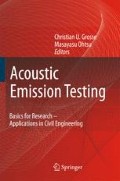Abstract
AE techniques have been extensively studied in concrete engineering for approximately five decades (Ruesch 1959). They are applied to practical applications (Ohtsu 1987) and are standardized in the code (NDIS2421 2000). This is because the increase in aging structures and disastrous damages due to recent earthquakes urgently demand for maintenance and retrofit of reinforced concrete structures in service. It results in the need for the development of advanced and effective inspection techniques. Thus, AE techniques draw a great attention to diagnostic applications in concrete.
Access this chapter
Tax calculation will be finalised at checkout
Purchases are for personal use only
Preview
Unable to display preview. Download preview PDF.
References
Berthelot JM, Robert JL (1987) Modeling concrete damage by acoustic emission. Journal of AE, 6(1):43-60
Colombo S, Forde MC, Main IG, Shigeishi M (2005) Predicting the ultimate bending capacity of concrete beams from the “relaxation ratio” analysis of AR signals. Construction and Building Materials 19:746-754
Fertis DG (1976) Concrete material response by acoustic spectral analysis. J Structrual Division, ASCE 102(ST2):387-400
Heam SW, Shield CK (1997) Acoustic emission monitoring as a nondestructive testing technique in reinforced concrete. ACI Materials Journal 94(6):510-519
JCMS-III B5706 (2003) Monitoring method for active cracks in concrete by acoustic emission. Federation of Construction Materials Industries, Japan
JSCE (2001) Standard specifications for concrete and concrete structures on maintenance. JSCE, Tokyo
Kobayashi AS, Hawkins NM, Chan YA, Lin IJ (1980) A feasibility study of detecting reinforcing-bar debonding by acoustic emission technique. Experimental Mechanics 20(9):301-308
Kunisue F, Yokoyama Y, Nogami K, Ohtsu M (2002) Quantitative evaluation of dynamic compaction process in fresh concrete. Proc. 1st fib Congress, Session 15-43
Li ZG, Li F, Zdunek A, Landis E, Shah SP (1998) Application of acoustic emission Technique to Detection of Reinforcing Steel Corrosion in concrete. ACI Materials Journal 95(1):68-76
Loland KE (1989) Continuous damage model for load-response estimation of concrete. Cement and Concrete Research 10:395-402
Matsuyama K, Fujiwara T, Ishibashi A, Fukuchi S (1997) AE measurement of reinforced concrete retaining wall. JSNDI, Proc. 9th AE Conf:131-136 (in Japanese)
McCabe W, Koerner M, Loard Jr. A (1976) Acoustic emission behavior of concrete laboratory specimens. ACI Journal 13(3):367-371
Mlakar PF, Walker R E, Sullivan B R, Chiarito V P (1984) AE behavior of concrete. In Situ/NDT Testing of Concrete. CANMET/ACI SP-82:619-637
NDIS 2421 (2000) Recommended practice for in-situ monitoring of concrete structures by acoustic emission. JSNDI, Tokyo
Nielsen J, Griffith DF (1977) Acoustic emission of plain concrete. J Testing and Evaluation 5(6):476-483
Niwa Y, Kobayashi S, Ohtsu M (1977) Studies of AE in concrete structures. Proc. JSCE 261:101-112
Niwa Y, Kobayashi S, Ohtsu M (1978) Studies of source location by AE. Proc. JSCE 276:135-147
Nomura N, Mihashi H, Niiseki S (1991) Influence of coarse aggregate size on fracture energy and tension softening of concrete. Concrete Research and Technology JCI 2(1):57-66
Ohtsu M (1987) Acoustic emission characteristics in concrete and diagnostic applications. Journal of AE 6(2):99-108
Ohtsu M (1988) Diagnostics of cracks in concrete based on acoustic emission. Nondestructive Testing, ACI SP-112:63-82
Ohtsu M, Murakami Y, Yuyama S (1995) AE generating behavior under Ccncrete Ppacement and application to process control. ASNT, Proc. AECM-5:332-339
Ohtsu M (1995) The history and development of acoustic emission in concrete engineering. Concrete Library of JSCE 25:121-134
Ohtsu M, Watanabe H (2001) Quantitative damage estimation of concrete by AE. Construction and Building Materials 15(5-6):217-224
Ohtsu M, Uchida M, Okamoto T, Yuyama S (2002) Damage assessment of reinforced concrete beams qualified by AE. ACI Structural Journal 99(4):411-417
Ohtsu M, Tomoda Y, Sakata Y, Murata M, Matsushita H (2003) In situ monitoring and diagnosis of RC members in an exposure test against salt attack. Proc. 10th Int. Conf. Structural Faults & Repair
Ohtsuka K, Date H, Kurita T (1998) Fracture process zone in concrete tension specimens by X-ray and AE techniques. Fracture Mechanics of Concrete Structures. Proc. FRAMCOS-3, AEDIFICATIO Publishers l. I:3-16
Ouyang C, Landis E, Shah SP (1992) Damage assessment in concrete using acoustic emission. ASCE, Nondestructive Testing of Concrete Elements and Structures:13-24
Reymond MC, Raharinaivo A, Brachet M (1983) Characterization of concrete damages by acoustic emission analysis. Journal of AE 2(3):159-168
Reinhardt HW, Grosse CU (2005) Final report of Rilem TC-185ATC: Advanced testing of cement-based materials during setting and hardening. RILEM Publications S. A. R. L., Bagneux, France
Rossi P, Godart N, Robert L, Gervais JP, Bruhat D (1994) Investigation of the basic creep of concrete by acoustic emission. Materials and Structures 27:510-514
Rusch H (1959) Physical problems in the testing of concrete. Zement Kalk Gips 12(1):1-9
Shiotani T, Bisschop J, van Mier JG (2002) Drying shrinkage microcrack measurements in cementitious composites using AE and FLM. SEM Annual Conference on Experimental and Applied Mechanics, Milwaukee
Tomoda Y, Ohtsu M (2005) Monitoring salt damage in reinforced concrete by AE. Proc. 3rd US-Japan Sym. on Advancing Applications and Capabilities in NDE, Maui, pp 236-241
Uddin FAKM, Numata K, Shimazaki J, Shigeishi M, Ohtsu M (2004) Mechanisms of crack propagation due to corrosion of reinforcement in concrete by AE-SiGMA and BEM. Construction and Building Materials 18:181-185
Weiler B, Xu SL, Mayer U (1997) Acoustic emission analysis applied to concrete under different loading conditions. Otto-Graf Journal 8:255-272
Wells D (1970) An acoustic apparatus to record emissions from concrete under strain. Nuclear Engineering and Design 12:80-88
Yoon DJ, Weiss W, Shah SP (2000) Assessing damage in corroded reinforced concrete using acoustic emission. J Engineering Mechanics, ASCE 26(3):189-194
Author information
Authors and Affiliations
Editor information
Editors and Affiliations
Rights and permissions
Copyright information
© 2008 Springer-Verlag Berlin Heidelberg
About this chapter
Cite this chapter
Ohtsu, M. (2008). Concrete. In: Grosse, C., Ohtsu, M. (eds) Acoustic Emission Testing. Springer, Berlin, Heidelberg. https://doi.org/10.1007/978-3-540-69972-9_10
Download citation
DOI: https://doi.org/10.1007/978-3-540-69972-9_10
Publisher Name: Springer, Berlin, Heidelberg
Print ISBN: 978-3-540-69895-1
Online ISBN: 978-3-540-69972-9
eBook Packages: EngineeringEngineering (R0)

